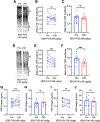Coagulation factor VIII regulates von Willebrand factor homeostasis invivo
- PMID: 37726033
- PMCID: PMC10842601
- DOI: 10.1016/j.jtha.2023.09.004
Coagulation factor VIII regulates von Willebrand factor homeostasis invivo
Abstract
Background: Coagulation factor VIII (FVIII) and von Willebrand factor (VWF) circulate as a noncovalent complex, but each has its distinct functions. Binding of FVIII to VWF results in a prolongation of FVIII's half-life in circulation and modulates FVIII's immunogenicity during hemophilia therapy. However, the biological effect of FVIII and VWF interaction on VWF homeostasis is not fully understood.
Objectives: To determine the effect of FVIII in VWF proteolysis and homeostasis in vivo.
Methods: Mouse models, recombinant FVIII infusion, and patients with hemophilia A on a high dose FVIII for immune tolerance induction therapy or emicizumab for bleeding symptoms were included to address this question.
Results: An intravenous infusion of a recombinant B-domain less FVIII (BDD-FVIII) (40 and 160 μg/kg) into wild-type mice significantly reduced plasma VWF multimer sizes and its antigen levels; an infusion of a high but not low dose of BDD-FVIII into Adamts13+/- and Adamts13-/- mice also significantly reduced the size of VWF multimers. However, plasma levels of VWF antigen remained unchanged following administration of any dose BDD-FVIII into Adamts13-/- mice, suggesting partial ADAMTS-13 dependency in FVIII-augmented VWF degradation. Moreover, persistent expression of BDD-FVIII at ∼50 to 250 U/dL via AAV8 vector in hemophilia A mice also resulted in a significant reduction of plasma VWF multimer sizes and antigen levels. Finally, the sizes of plasma VWF multimers were significantly reduced in patients with hemophilia A who received a dose of recombinant or plasma-derived FVIII for immune tolerance induction therapy.
Conclusion: Our results demonstrate the pivotal role of FVIII as a cofactor regulating VWF proteolysis and homeostasis under various (patho)physiological conditions.
Keywords: ADAMTS-13; coagulation factor VIII; proteolysis; regulation; thrombosis; von Willebrand factor.
Copyright © 2023 International Society on Thrombosis and Haemostasis. Published by Elsevier Inc. All rights reserved.
Conflict of interest statement
Declaration of competing interests X.L.Z. is a consultant and a member of the advisory boards for Alexion, Apollo, GC Biopharma, Sanofi, Stago, and Takeda. X.L.Z. is also the cofounder of Clotsolution. W.C. holds equity in Ivygen. All other authors have declared no relevant conflict.
Figures






References
-
- Wagner DD, Bonfanti R. von Willebrand factor and the endothelium. Mayo Clin Proc. 1991;66:621–627. - PubMed
-
- Mayadas TN, Wagner DD. von Willebrand factor biosynthesis and processing. Ann N Y Acad Sci. 1991;614:153–166. - PubMed
-
- Sadler JE. Biochemistry and genetics of von Willebrand factor. Annu Rev Biochem. 1998;67:395–424. - PubMed
-
- Dong JF, Moake JL, Bernardo A, et al. ADAMTS-13 metalloprotease interacts with the endothelial cell-derived ultra-large von Willebrand factor. J Biol Chem. 2003;278:29633–29639. - PubMed
-
- Dong JF, Moake JL, Nolasco L, et al. ADAMTS-13 rapidly cleaves newly secreted ultralarge von Willebrand factor multimers on the endothelial surface under flowing conditions. Blood. 2002;100:4033–4039. - PubMed
Publication types
MeSH terms
Substances
Grants and funding
LinkOut - more resources
Full Text Sources
Medical
Miscellaneous

